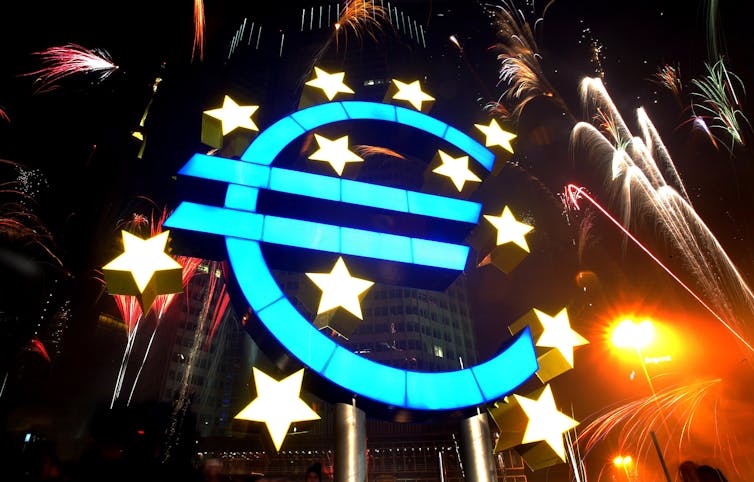New Year’s Day 1999 saw the largest monetary changeover in history. On that date, just 20 years ago, 12 members of the European Union formally adopted a brand-spanking-new currency, the euro.
Today seven additional EU member states use it, along with Montenegro, Kosovo, Andorra, Monaco, San Marino and Vatican City. If survival is the ultimate gauge of success, then this grand monetary experiment can be said to have succeeded.
But as investment advisers say, past performance is no guarantee of future results.
History lesson
To understand why, it helps to recall the motivations of the euro’s founders.
The first full-throated call for a single European currency was in the Werner Report issued in 1970. Its authors feared that the Bretton Woods system of currency pegs to the dollar was terminally ill and that its collapse would wreak havoc with exchange rates within Europe and therefore with the continent’s economy. The proposal was renewed in 1989 in the Delors Report, which presented a single currency as the capstone of Europe’s Single Market and its four freedoms: free movement of goods, capital, services and labor.
But these economic arguments did not suffice to tip the political balance toward the euro. In addition there was the belief of leaders like French President Francois Mitterrand and German Chancellor Helmut Kohl that a single European currency would apply irresistible pressure for political integration. It would lead eventually to their ultimate goal: a European political federation not unlike the United States.
Their logic ran as follows. To function smoothly, monetary union requires banking union – in other words, a single supervisor for all the banks and a union-wide deposit insurance scheme. Otherwise banks overseen only by their national supervisors would be allowed to undertake cross-border lending operations irrespective of the impact on neighboring countries. And in the absence of a union-wide deposit insurance scheme, a run on the banks in one country could infect the banking systems of its neighbors.
Similarly, to operate smoothly, a monetary union requires an integrated fiscal system, like those of political federations such as Australia and the United States. States that give up their monetary policy to a higher authority can no longer adjust it to changing national conditions. They can no longer lower interest rates to spur investment when the national economy is slowing more than those of its partners.
But if the partners operate an integrated fiscal system, the more prosperous members can shift resources to the depressed region, substituting for the no-longer-possible interest-rate cuts.
Here’s the rub: Banking union and fiscal union will only be regarded as legitimate if those responsible for their operation can be held accountable for their decisions by citizens. That means more power for the European Parliament – and less for national legislatures. It means that monetary integration creates a logic and therefore irresistible pressure for political integration.
Or so the euro’s architects believed.
The fly in the ointment
The problem is that the vast majority of Europeans, as distinct from the elites, don’t like the idea of giving up their national sovereignty. They identify as German or Italian first and as European only second, if at all.
They have little appetite for pooling national sovereignty at the European level. And 20 years of the euro have done little to change this.
Hence there was no banking union in the first decade of the euro. In its absence, large amounts of capital cascaded across Europe’s internal borders. Banks in Germany and France financed all manner of speculative investments in Irish and Spanish property markets and Greece’s public debt.
When, in 2008 and 2009, problems developed in the economies on the receiving end of these flows, the banks curtailed their lending. The Irish, Spanish and Greek governments, facing new constraints on their borrowing, were forced to sharply compress their spending, since there was no fiscal union to transfer resources to them from the more prosperous members.
But rather than advocating the creation such a system, nationalistic commentators in Germany and the members of the so-called New Hanseatic League – made up of eight northern European Union countries – warned of the dreaded specter of “transfer union.” In other words, they warned that cross-country transfers would all go one way, and that they would be on the paying, not the receiving, end.
In the absence of the political solidarity required for such transfers, the crisis countries were forced to double down on spending cuts. For them, the eurozone was transformed into an engine of deflation and depression.
The conclusion follows that absent a willingness to contemplate political union, banking union and fiscal union are not possible. And without them, monetary union by itself will not stand.

Still it breathes
Yet the euro is still with us.
It has survived for fully 20 years. It survived the mother of all stress tests, the global financial crisis.
As the Greek, Irish and Spanish crises all showed, and as the Italian crisis is showing again, exiting the euro is even harder than exiting the European Union.
As I explained more than a decade ago, abandoning the currency would ignite a full-blown financial crisis, as depositors frantically liquidated their bank balances and investors dumped their government bonds to avoid seeing their savings devalued. Each time a European leader, such as Greece’s newly elected Prime Minister Alexis Tsipras in 2015, has contemplated abandoning the euro, this specter has caused a reversal.
But neither is the alternative of far-reaching institutional reform in the cards. At their summit last month, European leaders agreed only to modest future steps to build out the monetary union.
They agreed to create a eurozone deposit insurance scheme, but only after problems of nonperforming loans in Italy and other countries were resolved, which is to say no time soon. They agreed to create a euro-area fiscal capacity, but only after high debts were brought down, which means not in this lifetime. They agreed to grant the European Stability Mechanism, the rescue fund established in 2012, additional resources and powers, but, again, only after existing bad-loan problems are addressed, which means at best in the very distant future.
This agreement falls far short of banking union, fiscal union and political union. It is an agreement to “work toward” rather than to “establish.” It will not change the operation of the monetary union.

Stumbling forward
So the euro will stumble forward. No one will be happy with its operation. Equally, no one will leave. Progress will be minimal, since there is no appetite for the political union needed to support fundamental reforms.
As a result, the euro remains vulnerable to another crisis. The next crisis could heighten the perceived urgency of fundamental reforms and lead Europe’s citizens to accept the modicum of political integration needed to implement them. So reformed and restructured, the euro would operate better.
Or the next crisis could empower anti-elite, nationalist, anti-EU – that is to say populist – politicians, making it impossible to implement even the modest reforms agreed in 2018.
In which case the euro will function even less smoothly.
Only one thing is certain. History doesn’t run in reverse. For better or worse – and both arguments can be made – the euro is here to stay.

